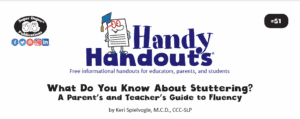Fluency
What is Stuttering?
Stuttering is more than just repeating words or getting stuck while speaking. While there’s no single agreed-upon cause or definition, we know that it can affect both how a child talks and how they feel about talking.
To better understand stuttering, it helps to look at it in two parts:
- Stuttering Behaviours – These are the speech patterns you might notice, such as repeating sounds or words, stretching out sounds, or pausing in the middle of a sentence. These are common in people who stutter.
- Stuttering Disorder – This includes everything else your child might go through because of those speech difficulties. It can affect their confidence, emotions, and how comfortable they feel speaking in different situations. It might even hold them back from doing things they want to do, like raising their hand in class or making new friends.
Understanding both the speech and emotional sides of stuttering helps us support children in the best way possible.
 A guide to help explain about how to recognize stuttering and what can be done to help children who do.
A guide to help explain about how to recognize stuttering and what can be done to help children who do.
Strategies and Resources:
-
Website Links
- HealthLinkBC: Stuttering (The difference between stuttering and normal dysfluency)
- HealthLinkBC: Normal Dysfluency
- The Canadian Stuttering Foundation: How to Recognize Stuttering
Information
- The Stuttering Foundation: 7 Tips for Talking with Your Child (Guidelines for to help adults talk to children who stutter)
- The Stuttering Foundation: Myths about Stuttering (Debunking common myths about stuttering.
